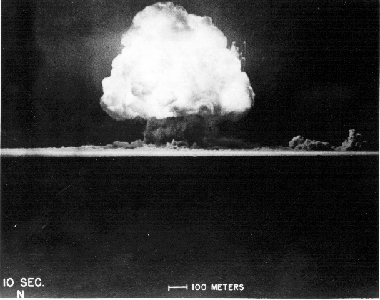Travel Pages
RomWell Travel Advisory
The Awesome Blast
After witnessing the awesome blast, Oppenheimer quoted a line from a sacred Hindu text, the Bhagavad-Gita: He said: "I am become death, the shatterer of worlds."[6] In Los Alamos 230 miles to the north, a group of scientists' wives who had stayed up all night for the not so secret test, saw the light and heard the distant sound. One wife, Jane Wilson, described it this way, "Then it came. The blinding light [no] one had ever seen. The trees, illuminated, leaping out. The mountains flashing into life. Later, the long slow rumble. Something had happened, all right, for good or ill."
General Groves' deputy commander, Brigadier General T. F. Farrell, described the explosion in great detail: "The effects could well be called unprecedented, magnificent, beautiful, stupendous, and terrifying. No man-made phenomenon of such tremendous power had ever occurred before. The lighting effects beggared description. The whole country was lighted by a searing light with the intensity many times that of the midday sun. It was golden, purple, violet, gray, and blue. It lighted every peak, crevasse and ridge of the nearby mountain range with a clarity and beauty that cannot be described but must be seen to be imagined..."
Immediately after the test a Sherman M-4 tank, equipped with its own air supply, and lined with two inches of lead went out to explore the site. The lead lining added 12 tons to the tank's weight, but was necessary to protect its occupants from the radiation levels at ground zero. The tank's passengers found that the 100-foot steel tower had virtually disappeared, with only the metal and concrete stumps of its four legs remaining. Surrounding ground zero was a crater almost 2,400 feet across and about ten feet deep in places. Desert sand around the tower had been fused by the intense heat of the blast into a jade colored glass. This atomic glass was given the name Atomsite, but the name was later changed to Trinitite.
RELATED LINKS:
 Learn About Trinity - The First Atomic Test
Learn About Trinity - The First Atomic Test
RECOMMENDED LITERATURE:
100 Suns - By Michael Light - Between July 1945 and November 1962 the United States is known to have conducted 216 atmospheric and underwater nuclear tests. After the Limited Test Ban Treaty between the United States and the Soviet Union in 1963, nuclear testing went underground. It became literally invisible—but more frequent: the United States conducted a further 723 underground tests, the last in 1992. 100 Suns documents the era of visible nuclear testing, the atmospheric era, with 100 photographs drawn by Michael Light from the archives at Los Alamos National Laboratory and the U.S. National Archives in Maryland. It includes previously classified material from the clandestine Lookout Mountain Air Force Station based in Hollywood, whose film directors, cameramen and still photographers were sworn to secrecy.
The title, 100 Suns, refers to the response by J. Robert Oppenheimer to the world’s first nuclear explosion in New Mexico when he quoted a passage from the Bhagavad Gita, the classic Vedic text: “If the radiance of a thousand suns were to burst forth at once in the sky, that would be like the splendor of the Mighty One... I am become Death, the destroyer of worlds.” This was Oppenheimer’s attempt to describe the otherwise indescribable. 100 Suns likewise confronts the indescribable by presenting without embellishment the stark evidence of the tests at the moment of detonation. Since the tests were conducted either in Nevada or the Pacific the book is simply divided between the desert and the ocean. Each photograph is presented with the name of the test, its explosive yield in kilotons or megatons, the date and the location. The enormity of the events recorded is contrasted with the understated neutrality of bare data.
Interspersed within the sequence of explosions are pictures of the awestruck witnesses. The evidence of these photographs is terrifying in its implication while at same time profoundly disconcerting as a spectacle. The visual grandeur of such imagery is balanced by the chilling facts provided at the end of the book in the detailed captions, a chronology of the development of nuclear weaponry and an extensive bibliography. A dramatic sequel to Michael Light’s Full Moon, 100 Suns forms an unprecedented historical document.
RECOMMENDED MOVIE:
The Day After Trinity - This unique movie is a haunting journey through the dawn of the nuclear age, an incisive history of humanity's most dubious achievement and the man behind it -- J. Robert Oppenheimer, the principal architect of the atomic bomb. Featuring archival footage and commentary from scientists and soldiers directly involved with the Manhattan Project, this gripping film is a fascinating look at the scope and power of the Nuclear Age.



